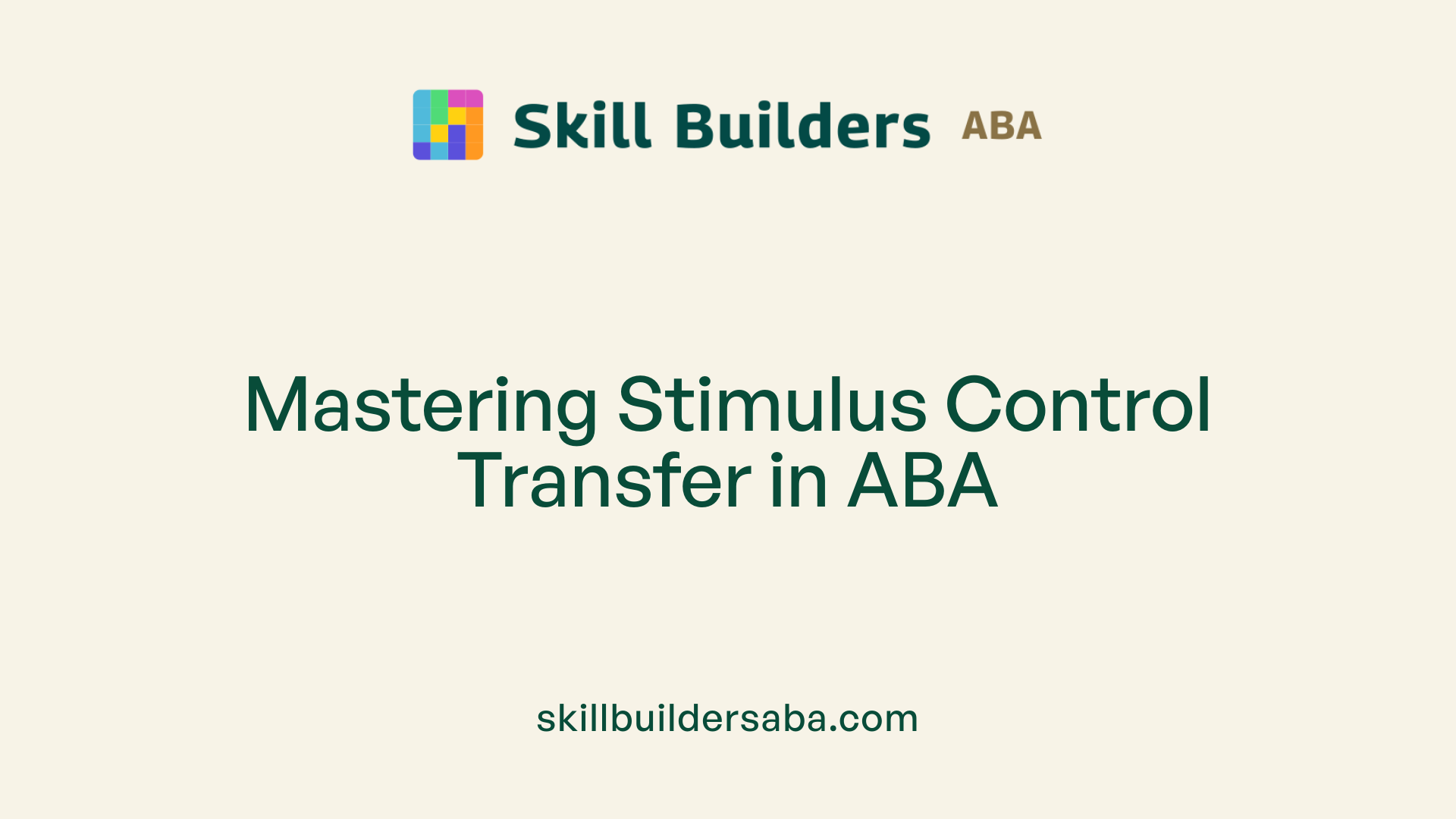
Shaping behavior using ABA techniques
Mastering the Art of Behavior Change with ABA Techniques
Understanding the Foundations of ABA and Shaping
Applied Behavior Analysis (ABA) is a scientifically supported method used to understand and modify behavior. Among its many techniques, shaping stands out as a fundamental approach for teaching complex skills and promoting meaningful behavior change. By systematically reinforcing close approximations of the desired behavior, shaping facilitates learning in a gradual, manageable manner. This article explores the principles, applications, and benefits of shaping within ABA, offering insights into how this technique can be effectively implemented across educational and clinical settings, especially for individuals with autism.
What is Shaping in ABA Therapy and How Does It Work?

What is shaping in ABA therapy and how does it work?
Shaping is a foundational technique used in Applied Behavior Analysis (ABA) that helps individuals learn new, often complex behaviors through gradual steps. It involves reinforcing behaviors that progressively get closer to the target behavior.
The process begins with a detailed task analysis, which means breaking down the overall skill into smaller, achievable parts or steps. For example, teaching a child to say 'mommy' might start with reinforcing any vocalization like 'mmm,' then moving on to sounds closer to the word, such as 'ma,' until the full word is achieved.
Once the steps are identified, the therapist or teacher reinforces each small success, known as successive approximations. This reinforcement encourages the individual to attempt the next step, gradually building up to the complete goal.
Reinforcement plays a crucial role in shaping behavior. Positive reinforcement, such as praise or a small reward, is given when the learner performs an approximation closer to the final goal. This motivates continued effort and progress.
Shaping is especially effective for teaching skills that are difficult to learn all at once, including speech, self-care routines, social interactions, and coping skills. It is a natural, patient process that can be tailored to each person’s unique abilities and pace.
Compared to other techniques like chaining, which also break down tasks but focus on sequential steps, shaping emphasizes gradually guiding an individual toward an ideal behavior by reinforcing their best attempt at each stage. This makes it a flexible and powerful tool in behavioral teaching.
Applying Shaping in Educational and Clinical Settings

How can shaping be applied in educational or clinical settings, particularly for individuals with autism?
Shaping is a versatile technique used extensively in educational and clinical contexts, especially for supporting individuals with autism. It involves carefully reinforcing small, successive steps that gradually lead a learner toward a complex or desired behavior. This systematic approach makes learning more manageable and less frustrating.
In practice, professionals begin by breaking down desired skills into smaller components through task analysis. For example, teaching a child to speak may start with reinforcing sounds that approximate the word, such as ‘mmm’ for ‘mommy,’ then gradually shifting toward clearer vocalizations. Reinforcement is provided for each small step, encouraging continued progress without overwhelming the learner.
This method is particularly beneficial for developing communication, social, and daily living skills. For instance, a child might be reinforced for tolerating brushing teeth, initially for a few seconds, then for longer durations. Over time, the child learns to tolerate full tooth brushing by incrementally increasing the behavior’s complexity.
Additionally, shaping can be tailored to fit each individual's learning pace. For example, in classroom settings, a student might be reinforced for staying seated for short periods initially, then gradually longer. In social skills training, reinforcement helps children approach peers step by step, fostering confidence and interaction.
Practical applications cover a wide range—from increasing participation in routines like table acknowledgment or sitting at a designated spot, to more complex skills like understanding social cues or managing transitions.
Research demonstrates that when applied properly, shaping supports skill acquisition and generalization across various environments. It promotes positive behaviors, reduces challenging behaviors, and builds resilience and independence in learners.
In summary, shaping serves as an effective, individualized method to teach new skills and promote behavioral development. Its use in autism intervention facilitates meaningful, confidence-building progress through systematic reinforcement of achievable steps.
Steps for Implementing Shaping Procedures

What are the key steps involved in implementing shaping procedures?
Implementing shaping in ABA involves a systematic process that guides individuals toward a target behavior by reinforcing progressively closer approximations. The first step is clearly defining the desired behavior. This means understanding exactly what the individual is expected to do once the process is complete.
Next, it is essential to conduct a task analysis. This involves breaking down the complex behavior into smaller, manageable steps or approximations. For example, teaching a child to say "mommy" might start with reinforcing initial sounds like "m," then progressing to "ma," and eventually the full word.
Differential reinforcement of successive approximations is central to shaping. At each stage, behaviors that resemble part of the target are reinforced, while behaviors that are less similar are not. This encourages the individual to consistently move closer to the final goal.
As development progresses, the criteria for reinforcement are gradually increased. This means raising the standards for what constitutes a correct or closer approximation, such as asking the child to say "mommy" more clearly or consistently.
Monitoring progress through data collection is vital. Regular tracking helps ensure that behavior change is occurring and that reinforcement is effective. Visual charts or logs can motivate learners by showing progress over time.
In summary, effective shaping involves several interconnected steps: defining the target behavior, breaking it into smaller steps, reinforcing successive approximations, gradually raising criteria, and consistently monitoring progress. This flexible and patient approach promotes steady skill development and helps make complex behaviors achievable through incremental steps.
Benefits and Effectiveness of Shaping in Behavior Modification

What are the benefits of using shaping in behavior modification?
Using shaping in behavior modification offers several important advantages that promote successful learning and behavior change. One of its primary benefits is that it simplifies complex skills by breaking them down into smaller, more manageable steps. This systematic approach allows learners to progress gradually, building confidence as they master each stage.
Shaping also helps reduce frustration. Since reinforcement is provided for achievements at each small step, learners remain motivated and engaged. This positive reinforcement creates a clear pathway to success, encouraging continued participation and effort.
Furthermore, shaping fosters confidence by celebrating incremental progress. Learners feel accomplished with each small success, which encourages them to try more advanced steps without feeling overwhelmed.
This technique is especially useful for developing daily life skills, communication, social behaviors, and overcoming fears. For example, it can be used to teach children to acknowledge a table, take steps toward it, and sit down — all reinforcing progress along the way.
Research indicates that shaping is highly effective across diverse settings, including classrooms, therapy centers, and even at home. It is adaptable for individuals with autism, developmental delays, or those working on personal growth goals. Overall, shaping provides a structured, supportive framework for promoting meaningful and lasting behavior change.
Contrasting Shaping with Other ABA Techniques
How is shaping different from other ABA techniques like chaining or discrimination training?
Shaping, chaining, and discrimination training are all foundational methods used in Applied Behavior Analysis to teach new skills, but they serve different purposes and operate through distinct processes.
Shaping focuses on developing a single behavior by reinforcing small, successive approximations—steps that gradually lead to the desired behavior. For example, if teaching a child to say "cookie," reinforcement would be provided for sounds like "mm," then "ma," and eventually full words.
Chaining involves teaching a sequence of behaviors where each step cues the next, enabling the learner to perform complex tasks. This can be forward chaining, backwards chaining, or total task chaining. For instance, teaching how to brush teeth by first teaching the initial step (picking up a toothbrush), then the next (applying toothpaste), and so on.
Discrimination training teaches individuals to differentiate between stimuli and respond correctly to specific cues. An example would be training a child to respond only to the word "sit" and not similar words or sounds.
While shaping emphasizes incremental progress toward one behavior, chaining builds entire routines from steps, and discrimination training sharpens stimulus control. All three tools are vital, but each targets different aspects of learning.
Examples of each technique in practice
| Technique | Example | Focus | Goal |
|---|---|---|---|
| Shaping | Reinforcing sounds closer to a word like "mommy" | Developing speech or complex behaviors incrementally | Vanishing prompts, smooth transition to target behavior |
| Chaining | Teaching a child to tie shoelaces | Building a sequence of actions into a routine | Complete task performance through step-by-step learning |
| Discrimination training | Teaching a child to respond only to "sit" | Developing stimulus control | Correct response to specific cues without confusion |
Understanding the differences helps in selecting the right approach for various learning goals, ensuring effective and individualized teaching strategies.
Practical Examples of Shaping in Action
Shaping is a versatile technique used across many settings to facilitate learning and behavior change. One common application is teaching verbal behaviors. For example, a child who is beginning to speak might be reinforced for making sounds that approximate words, such as saying 'mmm' for 'mommy,' then 'ma,' progressing gradually until they can say the full word. This step-by-step reinforcement helps the child refine their speech over time.
In daily routines and self-care skills, shaping makes seemingly complex tasks more manageable. For instance, a child learning to set the table might initially be reinforced for carrying utensils or placing a napkin, then progress to arranging all items properly. Similarly, for activities like brushing teeth, reinforcement could start with just touching the brush, then moving on to brushing for short periods, gradually increasing duration until the full routine is established.
Shaping also plays a vital role in overcoming fears, often through desensitization. This involves reinforcing small steps, such as standing a few feet away from a feared object or stimulus, then gradually moving closer and reinforcing each progression. This careful, incremental exposure helps reduce anxiety associated with phobias or stressful stimuli.
Academic skill development benefits significantly from shaping as well. For example, when teaching handwriting, a teacher might reinforce tracing or pre-writing strokes before moving to freehand writing. In math, progress might be reinforced as students master counting, then simple addition, and eventually more complex calculations.
These practical applications demonstrate how breaking down complex behaviors into small, achievable steps and systematically reinforcing each one can effectively promote skill acquisition. Whether in therapy, education, or everyday life, shaping encourages confidence, participation, and independence.
Understanding Stimulus Control Transfer in ABA

What is the process of stimulus control transfer in ABA?
Stimulus control transfer is a fundamental concept in Applied Behavior Analysis (ABA). It involves teaching an individual to respond correctly to a specific stimulus so that the desired behavior occurs consistently when that stimulus is present.
Initially, a prompt—such as a verbal cue, gesture, or physical guidance—is used to elicit the correct response. Over time, this prompt is systematically faded or withdrawn, encouraging the individual to respond independently to the stimulus. This gradual removal of prompts is crucial for establishing reliable behavior in natural settings.
The process is closely linked to shaping, where successive approximations of a target response are reinforced. As the individual progresses, reinforcement is provided only when they respond accurately to the stimulus without prompts. This strengthens the association between the stimulus and the desired behavior.
Establishing stimulus control is especially important for individuals with autism and other developmental disabilities. It helps them follow routines or rules, participate more actively, and reduces behaviors that are problematic or not contextually appropriate.
By ensuring that behaviors are emitted in the right contexts, stimulus control transfer makes learning more effective and supports generalization across different environments, teachers, and caregivers.
How do prompting and fading techniques facilitate stimulus control?
Prompting involves providing assistance to elicit the correct response from the learner. This assistance can take many forms—gestural prompts, verbal cues, physical guidance, or visual aids.
Fading is the systematic process of gradually reducing the prompt's intensity or frequency as the learner begins to master the response. For example, a teacher might initially physically guide a child's hand to write a letter. Over days or weeks, the physical prompt is increased in distance or complexity until the child begins to perform the task independently.
These techniques work together to transfer stimulus control by initially creating the conditions that produce the correct response, then reducing assistance step-by-step so the learner responds correctly without external aid.
Why is stimulus control important for behavior reliability?
When a behavior is under stimulus control, it occurs reliably and predictably in response to specific cues. This consistency is crucial for teaching complex skills or routines, such as toileting, dressing, or academic tasks.
Reliable performance in natural environments means the individual can function independently and increase their confidence. It also reduces problem behaviors that may occur when individuals are unsure about what is expected or when they respond to irrelevant stimuli.
How is stimulus control transfer applied in teaching routines?
In practical settings, stimulus control transfer can be used to teach everyday routines, like handwashing or cleaning up toys. The process involves initially prompting the routine and reinforcing correct performance.
As the learner becomes more independent, prompts are gradually faded, and reinforcement is provided solely for correct responses to the natural cues—such as seeing the soap or a clean towel.
For example, in teaching a child to acknowledge a table before eating, the teacher might prompt the child to look at the table initially. Over time, the prompts are faded, and the child learns to look at the table independently before eating, responding to the stimulus reliably.
This method makes routines automatic and reduces dependence on prompts, fostering independence and confidence in learners.
Harnessing the Power of Shaping for Lasting Behavior Change
Shaping is a cornerstone technique in ABA that empowers individuals to acquire new skills, diminish problematic behaviors, and foster independence. Its incremental, reinforcement-based approach makes learning accessible and tailored to each individual’s needs. By systematically reinforcing successive approximations, practitioners and caregivers can guide behavior development in a positive, effective manner, supported by extensive research evidence. Implementing shaping across diverse settings—be it in classrooms, clinics, or home environments—can lead to meaningful, enduring change. Understanding and applying this technique is essential for advancing behavior modification interventions that create lasting impacts and improve quality of life.
References
- Behavior Shaping & Gradual Steps Toward Positive Change
- Understanding Shaping and Chaining in ABA Therapy
- Shaping - Association for Science in Autism Treatment
- Shaping in ABA: Unlocking Your Child's Potential
- Shaping: 5 Tips You Need to Know to Use it Effectively
- How Shaping Behavior in ABA Helps Develop Key Skills
- How to Use Shaping Procedures in ABA
- Using Shaping to Teach New Skills - Behavior Resources, Inc.
Reach Out Today
Learn more about how we can support your child’s growth and development. Contact us to discuss our services and availability in your area.
.svg)